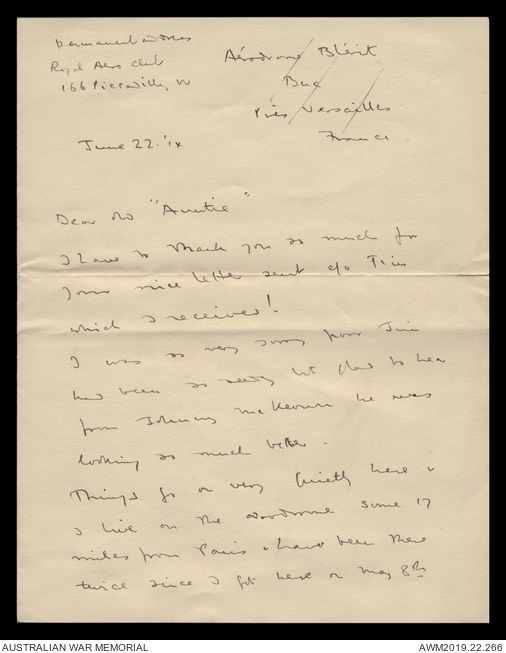| Ranks Held | Captain, Lieutenant Colonel, Major, Temporary Lieutenant Colonel |
|---|---|
| Birth Date | 11/02/1878 |
| Birth Place | United Kingdom: England, Dorset, Bournemouth |
| Death Date | 21/05/1921 |
| Death Place | Australia: New South Wales, Sydney, Newport |
| Final Rank | Lieutenant Colonel |
| Service | Australian Imperial Force |
| Units |
|
| Places | |
| Conflict/Operation | First World War, 1914-1918 |
Lieutenant Colonel Walter Oswald Watt
Walter "Toby" Watt was born to a wealthy family in Bournemouth, England, on 11 February 1878. When he was one year old, his mother died, and Walter spent ten years in Australia. He returned to England in 1888 and later completed two university degrees, a Bachelor of Arts in 1899 and a Master of Arts in 1902 from Cambridge University. He returned to Australia in 1900 and joined the New South Wales Scottish Rifles with the rank of lieutenant. He was promoted to captain in 1902 and served with this unit until 1907. Watt married Muriel Williams in 1902. In the same year, he was appointed aide-de-camp to the New South Wales Governor, Admiral Sir Harry Rawson. At about this time, Watt also purchased significant cattle station holdings in New South Wales and Queensland. On a later trip to England, Watt undertook flying training and obtained his Royal Aero Club certificate in 1911, the first Australian to do so.
Watt was divorced in 1913 and went to Egypt, where he purchased and flew a Bleriot XI aeroplane. He formed a friendship with both Louis Bleriot and Roland Garros, who were in Egypt at the time.
In 1914 Watt left Egypt and started work with the Bleriot aircraft factory in Paris. On 2 August 1914, the day France declared war on Germany, he offered his flying services and his plane to the French war effort, which was accepted. He joined the French Foreign Legion military aviation division. For his aviation services with France from 1914 to 1916, he was awarded the French Legion of Honour and Croix de Guerre. Following a suggestion from his French command, Watt enlisted in the Australian Imperial Force (AIF) on 1 March 1916 and was released from the French Foreign Legion to transfer to the AIF in April 1916. Watt joined the Australian Flying Corps (AFC) as a captain attached to No. 1 Squadron (referred to as No. 67 Squadron RFC by the British).
Watt embarked from England for Egypt in May 1916 and took command of No. 1 Squadron AFC. In October 1916, Watt was mentioned in despatches for his service with the squadron in Alexandria, as part of the Egyptian Expeditionary Force. In the same month, he was appointed acting in command of No. 2 Squadron AFC (referred to as No. 68 Squadron RFC by the British). In December he was promoted to major and took permanent command of No. 2 Squadron. In January 1917, Watt was transferred with his unit from Alexandria to England and by May, he was in command of the School of Aerial Gunnery at Turnbury, England. Watt was then attached back to the No. 2 Squadron in June 1917. In September 1917, his unit went to France. Charles Bean visited No. 2 Squadron in November 1917 and recorded the excellent work performed by Watt and his unit.
In 1918 a concert was held in France by the Kookaburras Concert Party of No. 2 Squadron AFC to farewell Major Watt, in recognition of the high esteem in which he was held by his unit. Watt was promoted to Lieutenant Colonel and transferred to England in February 1918 to take command of the 1st Training Wing (5, 6, 7 and 8 Squadrons RFC). In April 1918 he was in command of the School of Special Flying at Gosport, England, and then in command of 1st Wing Headquarters.
In April 1918 Watt was again mentioned in despatches, this time by Sir Douglas Haig, Commander of the British Expeditionary Force on the Western Front, and in January 1919 Watt was awarded an Order of the British Empire.
Watt embarked for Australia on the troopship Kaiser-I-Hind in May 1919, arriving in Australia on 19 June 1919; on 3 August 1919 his appointment was terminated.
Following his war service, Watt became engaged in lobbying for improvement in civil aviation safety and was extensively involved in various business interests. These included involvement in a family shipping company and directorships in companies engaged in art, tin mining, and production of alum and rubber. He declined various offers, among them to be controller of civil aviation, standing for parliament, and to join the newly formed Royal Australian Air Force.
Walter Watt drowned at Bilgola Beach, Newport, New South Wales, on 21 May 1921, aged 43. He was accorded a military funeral and his ashes are buried at St. Jude's church, Randwick, New South Wales.




